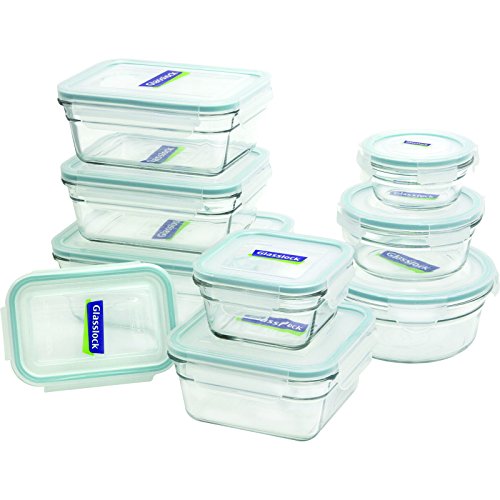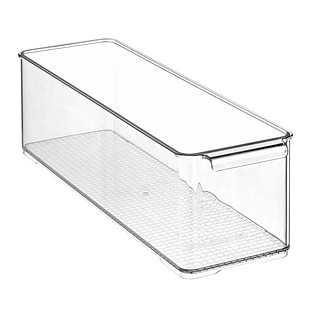How to Organize a Fridge to Help Keep Everything Fresh

Our evaluations and opinions are not influenced by our advertising relationships, but we may earn a commission from our partners’ links. This content is created by TIME Stamped, under TIME’s direction and produced in accordance with TIME’s editorial guidelines and overseen by TIME’s editorial staff. Learn more about it.
There is nothing worse than opening your refrigerator and not being able to find fresh food because you’ve crammed too many containers, jars, and bottles onto your shelves.
An overstuffed fridge can not only negatively impact the shelf life of your groceries, but may even impact your health. It’s hard to make home cooked meals or even a snack when you can’t find what you are looking for in your fridge. In addition, an unorganized fridge may lead to food waste, which, personally, our family tries (and often fails at) to avoid.
An organized fridge will keep food fresher, longer and help reduce food preparation stress. In addition, keeping your products stored correctly is a food safety strategy. If you don’t properly store meat or dairy products, you run the risk of contamination and food poisoning, which may occur when your groceries are not properly stored.
First, throw away that curdled container of milk, then read below to repair your relationship with your refrigerator and its contents. Quick note, for this article I only focused on the refrigerators versus freezers, but many of these tips apply to keeping your food safe when frozen.
To best organize your fridge, whether it be a French door or a side-by-side, consider the appliance you have—not the one you want. Do you have a two-door fridge? Do you need more shelving? Look for a refrigerator designed with them. Is your freezer on the top or the bottom? How many shelves and temperature zones is your fridge? These are good questions to ask before you begin your reorganization.
In most modern refrigerators, there can be zones with different temperatures and separate sections for food, including top, middle, and bottom shelves, bins, side shelves, and other compartments.
According to the USDA website, “bacteria grow most rapidly in the range of temperatures between 40 and 140 °F, the "Danger Zone," some doubling in number in as little as 20 minutes. A refrigerator set at 40 °F or below will protect most foods.”
Zones are important when it comes to different products. For example, pasteurized milk should be stored below 37 F and ideally between 33 and 36 F, according to Wasatch Milk, a Salt Lake City-based company that offers delivery of local dairy, meat, and other products.
If you don’t store food at the proper temperature, it could go bad prematurely, wasting food and, even worse, make someone in your family very ill.
Your fridge should be organized to enhance food safety and make it easy for you (and family members) to retrieve what you need easily without doing the “open the door” and staring foggily through a wall of food products, which has happened on more than one occasion around our home.
We try to clean and organize our fridge at least a few times a month, usually after a grocery or farmers market haul, and it makes a huge difference when it comes to meal prep and stress in the kitchen. Professionals suggest organizing your fridge in the following ways, while adhering to proper temperature zones, but feel free to do what works best for you.
I recently discovered we were storing the wrong things, like eggs, on our top shelf. It turns out that the top shelf (often the least cool part of the fridge) should be where you put “ready-to-eat” treats like prepared foods and leftovers that don’t need to be reheated. This is where you could also store any snacks that you might enjoy cold, but are shelf-stable, like pre-packaged sliced turkey or other cooked deli meats, if you don’t have a separate meat drawer for them. Pickles, olives, and hard cheese should be ok, as well. This is where those containers of leftovers should live, too.
This is where I moved the eggs in accordance with safe food practices and dairy like unpasteurized and pasteurized cheeses, milk, butter, cream cheese, and dairy-based desserts. The middle shelf is usually the most temperature-stable shelf, meaning you won’t likely see any big changes in temperature that can occur with bins or drawers in the lower part of the fridge.
The bottom shelves are often the coldest part of the refrigerator, so this is where you should keep meat, fish, and poultry–even better if you have a designated meat drawer. Don’t allow meat juices or any other item to leak, and keep it in a plate, bowl, or designated container in case of leakage from a package.
At the end of the day, bottom shelves should be reserved for raw foods that must be cooked to be safe. You want to keep all meat (in addition to fish and poultry) on their shelves to avoid contamination with other food. If you eat deli meats and cheese, always use the designated lower drawer if your fridge has one.
Most fridges have drawers or designated fruit and vegetable bins. We used to toss everything green (and other brightly colored items) into one bin. It turns out (no surprise) that we have been storing our fruits and vegetables together–and they don’t make good roommates.
According to research by Michigan State University’s Extension, which is a network of departments and professionals from the university that collaborate to share its knowledge base, from food safety to farming, states in an article by Jeannie Nichols, a former food safety educator at MSU, “vegetables like high humidity and fruits like low, so do not put fresh fruits and vegetables in the same drawer. Produce also gives off a gas that makes other fruits and vegetables ripen quickly. Fruits produce the most gas.”
That said, make sure to toss your vegetables in one bin and your fruit in the other, and check the humidity levels of your drawer to see if you can set the humidity in your fridge, which newer appliances usually have available. Remember that leafy vegetables should remain in a high-humidity environment, keeping everything crisp and delicious for your next salad.
Our fridge has a separate “drinks” shelf with a water filter and room for shelf-stable juices, sodas, and other drinks, except for milk and cream, which should be kept towards the back of your middle shelves. Unfortunately, here, it is often a receptacle for whatever we can’t fit in the fridge. When you have shelving or anything built into the refrigerator doors, understand that this area is the most unstable in terms of keeping things cold. The best things to keep in these areas are your condiments, like ketchup, mustard, soy sauces, jams, and jellies. You could also move your pickles and olives from your top shelf here safely, as well.
When you are getting ready to organize your fridge, it is important to deep clean it. Remove items, such as shelves and bins. If they are extra dirty, you can soak in a mixture of mild dish detergent.
According to the USDA Refrigeration and Food Safety guidelines, you should always avoid using solvent cleaning products, abrasives, and any cleansers that might transfer a taste or smell to food or cause damage to your fridge. Start at the top and clean your way down. Don’t neglect the door and any side shelves where condiments may have leaked and liquids or solids have congealed. When you have cleaned the fridge, you can put back all shelves, bins, and/or compartments you have removed to clean.
One way to make sure everything in your fridge is grouped easily together is to use fridge organizers. The benefits include seeing if food is past its expiration date, easily grabbing what you need, and keeping your fridge tidy and organized. Fridge organizers increase space, can help you plan your meals (because you can easily see what you have on hand), and may even lower stress%20and%20heightened%20depression%20symptoms) caused by clutter.
Here are a few types of fridge organizers to consider:
Leftovers will likely get eaten when stored in these glass containers, which are designed to keep food items separated and fresh. Also, eating more fruits and vegetables is easier when they are cut up and easily accessible.

We all know the Container Store is a one-stop shop for organization. This brand doesn’t neglect your kitchen. I love these wide fridge bins with dividers because they can be used on middle shelves to separate deli meats, cheese, and snacks, and the lower bins can be used to separate fruit and vegetables (just check if you can set humidity levels on each side where you place them). Easy to pull out and use, and are stackable. Downside, you have to wash by hand but that wouldn’t deter me from purchasing them. If you have a large fridge, these might be a good option for organizing by bin.

I love how it keeps condiments or drinks together and can move easily in and out of the shelf, with its two rear wheels and easy-to-grip handles. It would be great for a smaller fridge, given that it is only six inches wide, but if your fridge is larger, simply buy two—a great option for storing bottles without laying them on their side.

Food safety should always be at the forefront of your mind when organizing your fridge. Keep uncooked fish, meat, and poultry in the coldest part of your refrigerator, like a temperature-controlled meat drawer or the bottom shelf. Leftovers, along with pickles or olives, can live on the top shelf, and fruits and vegetables should live (ideally in separate bins) with humidity control towards the bottom of your fridge. Middle shelves are ideal for eggs and dairy products like yogurt and cheese. Keep your milk and cream towards the back of the shelf for optimal cold storage.
Always clean up spills in your fridge immediately, and do a once-a-week check on food spoilage, but otherwise, a deep clean every three to four months, plus a reorganization when you do the deep clean, should suffice, according to cleaning experts.
A small fridge should follow the guidelines for a larger refrigerator regarding which products should go from top to bottom. Space-saving containers are a great option for a small fridge, so you can organize your groceries in groups, making it easier to fit everything into the space. Products that help hack a small fridge:
If your refrigerator has limited space, not only can regular deep cleans (and clean-outs) help you keep things nice and neat. After you organize your fridge, weed out the old food, including those nearly-empty condiment bottles, at least every other week, or as often as you fill your fridge after a grocery haul. When you go to the store, try to buy only what you need and keep shelf-stable items that can be stored in a pantry out of the fridge until you need them.
Limited space means you may have to get creative, like transferring liquids into smaller bottles, only saving leftovers you know will be eaten in the next day or two, and consider chopping up fruits and vegetables that may take up space in bulk and keeping them in smaller containers. When you have limited space, it is always a good idea to streamline and simplify what you put into it.
The information presented here is created by TIME Stamped and overseen by TIME editorial staff. To learn more, see our About Us page.



